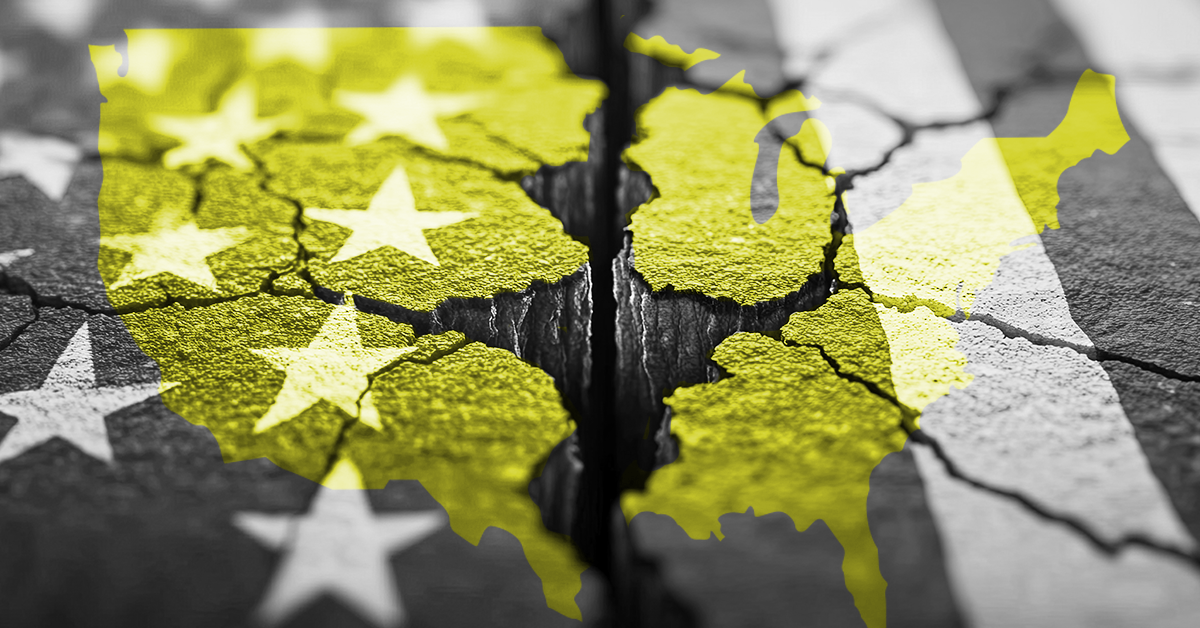Trump’s Travesty on the American Brand
Jun 23, 2025 / By Vanessa Horwell
5 Min Read
The tarnishing of the American brand
U.S. policy is rapidly changing. The points detailed in this post were accurate at the time of publication.
As tanks roll down the streets of Washington, D.C., uninvited National Guardsmen occupy Los Angeles and secret police conduct accountability-free immigration raids in communities across the country, there are legitimate questions about what America even is as a nation anymore. I’m not a political scientist or a historian, and though I think I can identify a wannabe king when I see one, I’m not qualified to say whether these first five months (5 months!) of Trump’s second term have fundamentally reshaped our republic.
But I am a marketing expert, and I can tell you that this administration has irrevocably damaged the United States’ brand. In fact, almost nine years ago, I warned of exactly that.
When I re-read that 2016 post, what’s most striking isn’t the fact that all of those warning signs came to fruition, but how quaint the numbers seem. Trump’s first-term plan to deport 11 million immigrants? Now the goal is 20 million. A 45% tariff on Chinese goods? Try 145% (or maybe it’s 55% now? It’s hard to keep track). Global trade “plateauing” amid the protectionist rhetoric of the 2015-2016 campaign? How about the “weakest economic growth since the 1960s,” per the World Bank.
If the prospect of Trump 1 was enough to tarnish the American brand, the reality of Trump 2 is distorting it beyond recognition.
Diminishing dollar, poorer perception
For a glimpse into how much the American brand has been devalued in financial terms, just look at U.S. Treasuries. The bond market is as volatile as it’s been since the Great Recession, due entirely to Trump’s unilateral trade war.
The yield on the 30-year U.S. Treasury rose 60 basis points to over 5% following the “Liberation Day” tariff announcement, one of the largest moves within a single week since 1981. Various tariff pauses and bilateral deals have reined in the 30-year rate a bit (as of this writing, it stands at 4.89%), but the whiplash effect has already done damage. Volatility, escalating trade tensions and geopolitical upheaval are making investors wary of holding American debt. Foreign buyers are seeking asset vehicles other than U.S. bonds, long considered the safest haven on earth. As we’ve written about for specific industries like aviation and financial technology, the uncertainty is causing chaos and harming our brand.
Treasuries aren’t the only barometer of global sentiment towards “Brand America;” several studies have quantified the impact of Trump’s policies on how the U.S. is perceived. Ipsos research released last month found that the proportion of countries that think the U.S. will have a positive influence on world affairs has dropped from 77% in October 2024 to 63% in May 2025.
For the first time ever, more people see China as a positive force in world affairs than they do the United States. Let me say that again: For the first time ever, more people see China as a positive force in world affairs than they do the United States.
According to the Democracy Perception Index survey, the net perception rating of the U.S. fell to -5% from +22% last year, indicating a greater number of respondents with a negative view of the country compared with those with a positive view. If a consumer-facing corporation saw this precipitous drop-off in brand perception over the same period, its board would summarily dismiss the entire C-suite.
Travel’s tariff trouble, border barriers
How is a deteriorating American brand affecting individual industries? To be sure, there are winners and losers, but the general sense has been profoundly negative. In one of the most important industries for THINKINK, travel, the impacts are especially pronounced.
Instead of the high-growth year most travel analysts had predicted in late 2024, inbound travel to the U.S. is now projected to decline by 9.4%. Canadian travel to the United States is down for a third consecutive month, falling to 15.2%. Airlines have reduced domestic fares, and hospitality brands are slashing their revenue outlooks. The New York Times has declared a Summer Travel Slump attributable to tariffs and unpopular policy decisions. The Wall Street Journal reports that Tourists Are Saying No to America and taking their travel dollars elsewhere.
Economic jitters are making Americans warier about travel as well—even within the United States. The share of Americans planning to take a vacation in the next six months slipped below 40% in February for the first time since the pandemic. The Ipsos Consumer Tracker for May not only found that fewer Americans have international travel plans for this summer than last (27% in 2025 vs. 34% in 2024), but they are also less likely to plan a trip within the U.S. And if they do, they are opting for shorter vacations and road trips over air travel.
All of this is leading us into what Skift CEO Rafat Ali describes as "The Silent Years" of the U.S. travel industry. As we noted last month, the financial impact of the Trump Travel Slump will be felt across the sector, and it all stems from America’s brand taking on a decidedly unwelcoming tone.
Corporate travel curbed, events held elsewhere
While we think of brand sentiment as a consumer phenomenon, it, of course, plays a huge role in businesses’ decision-making, too. Which is why U.S.-bound corporate travel is feeling the same pressures as the leisure segment. As travel industry analyst and investor Henry Harteveldt recently put it, “I am extremely concerned that the damage being done to the U.S.'s reputation as a destination to visit, whether for business or personal travel, may be difficult to repair.”
It comes down to a fundamental question: why would you hold business events in a country that doesn’t want you? The increase in draconian policies like border searches (up 10% YOY) and immigration detainments are prompting organizations to reassess the risks and protocols around even routine work travel. As a result, European business travel bookings to the U.S. in April dropped 26% compared to the same month last year as companies seek markets offering “greater stability.” And who would blame them?
Not only are business travel inflows being negatively impacted, other countries are taking the reverse side of that transaction. Flight Centre Travel Group has reported significant year-on-year increases in flight bookings from the U.S. to several international markets in April, signaling that corporate travel isn’t slumping; it’s just that the U.S. is no longer benefiting from it.
None of this even accounts for the most recent curb on inbound travel, the renewed Trump travel bans. By fully restricting travel from 1236 countries and partially limiting entry from 19 others, this administration has put the U.S. squarely in the isolationists’ club. We’re now counted among nations any outside observer would consider xenophobic and plurality-adverse, like North Korea (which, ironically, does not appear on either ban list).
Are these the actions of a country that wants to host—and economically benefit from—thousand-attendee international conferences? Let’s hope that not too many of the countries that qualify for next year’s World Cup, which is expected to generate $30.5 billion in economic output in the U.S., end up on the banned list.
All of these impacts, from the bond markets to leisure and corporate travel, are ultimately functions of the American brand. The Trump administration is actively denigrating it, and there’s so much more damage to come. Will anyone still see the value in buying it?
I have so many questions and no real answers. What are we going to do to defend Brand America? Can we collectively change its downward spiral and demise? You can write to me at vhorwell@thinkinkpr.com.
Sign up for our insights on the convergence of business and PR







